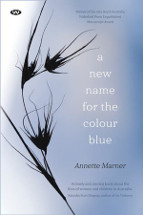A new name for the colour blue by Annette Marner

Wakefield Press, 2020. ISBN: 9781743057018.
(Age: Adult) Highly recommended. Scotoma can occur when our brain
does not register something the eye sees because it does not fit
within our mental framework. In Annette Marner's novel, a simple
exercise in a training session at work leads arts administrator and
artist, Cassandra, to ponder what else she does not see, or sees
incorrectly. From the intense but violent relationship with Stephen
the saxophone player, to the central mystery of her life, the
disappearance of her Aboriginal childhood friend Tania, Cassandra is
trapped in a role where her rage, or her sadness, is always stifled,
and she continues a life of not seeing, of not wanting to see; a
life of submission.
In the first chapters Marner vividly and realistically portrays the
intensifying path of domestic violence, and then moves on to expose
the long term influences of men's oppression of women, and the
mirror of the colonial oppression of the Aboriginal people and the
country that belonged to them.
Cassandra's childhood in the southern Flinders Ranges is one of
harsh men and long suffering women, boys' cruelty and girls' fear,
and of stolen land and Aboriginal dispossession. Tania's
disappearance is in fact a collusion to not face truths, to cover up
and deny; something that has a long history in Australia.
Marner's novel is not a simple mystery story; it is a complex
interweaving of many themes from Australia's dark past along with
the story of a woman's journey towards self-understanding and
empowerment. As an artist Cassandra has to find her vision, and new
names for colours that have always been labelled by the dominant
culture. There are many references to famous artworks that
complement and enrich the narrative.
Themes: Domestic violence, Racism, Aboriginal rights, Women's
rights.
Helen Eddy